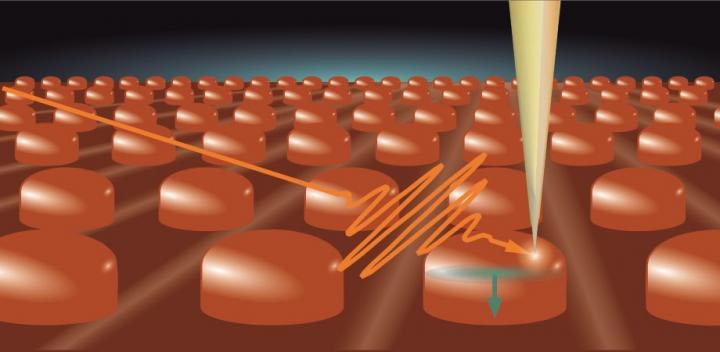Nanodots made of photovoltaic material support waveguide modes

New spectroscopic technique for studying nanostructures demonstrates that stibnite nanodots can act as high-optical-quality waveguides and are promising candidates as photoswitchable materials for future applications
Credit: Zhan et al., doi: 10.1117/1.AP.2.4.046004
New spectroscopic technique for studying nanostructures demonstrates that stibnite nanodots can act as high-optical-quality waveguides and are promising candidates as photoswitchable materials for future applications.
Antimony sulfide, or stibnite (Sb2S3), has been investigated intensively in recent years as a promising material for nontoxic, environmentally friendly solar cells. It is now possible to fabricate thin photovoltaic films from an ink containing nanoparticles of stibnite, and to nanopattern those films for 2D and 3D structures of pretty much any shape. Such simple, cost-effective production methods fulfill prerequisites for reliable, widespread use.
Since stibnite is an effective semiconductor (i.e., it has a high absorption coefficient and carrier mobility), its nanostructure holds promise as a photoswitchable material for all-optical signal processing and computing. Petra Groß, researcher at the Institute for Physics at University of Oldenburg explains, “Illumination with near-infrared light, with wavelengths for which stibnite is largely transparent, can result in an ultrafast change of its refractive index. This means that a surface patterned with stibnite nanoparticles could enable optical properties like reflection of color appearance to be switched by an infrared light pulse.”
If stibnite nanostructures are to be used in switchable nanodevices, high optical quality is essential. A recent study published in Advanced Photonics investigated the optical properties of stibnite nanostructures. The study demonstrated that stibnite nanodots can act as high-optical quality waveguides. This finding, together with the easy 2D and 3D structuring capabilities and interesting optical properties, indicates strong potential for stibnite nanostructures as switchable materials for future applications.
Stibnite nanodots
The lead author of the study, Jinxin Zhan, is currently a doctoral student in the Near-Field Photonics Laboratory of Professor Christoph Lienau at University of Oldenburg. Zhan explains that electron microscope images of stibnite indicate a rather uneven surface. Collaborating with researchers at University of Konstanz, Zhan and her team aimed to estimate the optical properties of the stibnite nanostructure by investigating stibnite nanodots (400-nm diameter) atop a stibnite surface.
Zhan says, “Such an optical inspection is difficult. The size of the nanostructures is usually smaller than the wavelength of visible light, such that spectroscopic measurements are typically performed only on ensembles of several nanostructures.”
Nanoparticle focus
To achieve the difficult optical inspection, Zhan and her team developed a novel kind of near-field spectroscopy that allows optical study of single nanoparticles. It is based on scattering-type scanning near-field optical microscopy (SOM), where a gold probe with a sharp tip of about 10-nm radius of curvature is brought close to nanostructure’s surface and scanned across it. The light scattered away from the structure by the tip is collected by a detector.
Zhan notes, “Usually, there is a large amount of background light present, which we suppress by modulating the tip-sample distance and by mixing the scattered light with a broadband reference laser. A monochromator equipped with a fast line camera enables us to measure complete spectra at every position while raster scanning.” The spectral bandwidth is 200 nm, and the spatial resolution is about 20 nm, such that the team can study the optical properties, or spectrally resolved intensity profiles, within individual nanodots.
The resulting maps of the stibnite nanoparticles revealed that they act as high-refractive index, dielectric waveguides, despite their irregular surface apparent in structural studies. Zhan explains further, “With our new method, we see mode profiles across the nanodots that are very similar to the mode profiles of guided waves in optical glass fibers. A calculation shows that a cylindrical waveguide of stibnite with 400-nm diameter should support four modes. A calculated superposition of these four lowest-order modes matches our experimental observation very well. These modes are supported over the whole 200-nm bandwidth of our near-field spectroscopy measurement.”
Lienau noted that this novel technique offers a totally new way of “seeing” minute amounts of nanomaterials and opens the door towards studying the dynamics of their optical excitations on ultrafast time scales. He says, “The spectroscopic technique developed by Jinxin Zhan and Petra Groß is exceptionally promising. Already now, the team has demonstrated local light scattering spectroscopy with deep subwavelength resolution and high sensitivity. We are confident that we will be able to further improve the spatial resolution to the few-nanometer range quickly.”
###
Read the original open access research article: Zhan et al., “Spatial and spectral mode mapping of a dielectric nanodot by broadband interferometric homodyne scanning near-field spectroscopy,” Adv. Photon. 2(4), 046004 (2020), doi 10.1117/1.AP.2.4.046004.
Media Contact
All latest news from the category: Materials Sciences
Materials management deals with the research, development, manufacturing and processing of raw and industrial materials. Key aspects here are biological and medical issues, which play an increasingly important role in this field.
innovations-report offers in-depth articles related to the development and application of materials and the structure and properties of new materials.
Newest articles

Parallel Paths: Understanding Malaria Resistance in Chimpanzees and Humans
The closest relatives of humans adapt genetically to habitats and infections Survival of the Fittest: Genetic Adaptations Uncovered in Chimpanzees Görlitz, 10.01.2025. Chimpanzees have genetic adaptations that help them survive…

You are What You Eat—Stanford Study Links Fiber to Anti-Cancer Gene Modulation
The Fiber Gap: A Growing Concern in American Diets Fiber is well known to be an important part of a healthy diet, yet less than 10% of Americans eat the minimum recommended…

Trust Your Gut—RNA-Protein Discovery for Better Immunity
HIRI researchers uncover control mechanisms of polysaccharide utilization in Bacteroides thetaiotaomicron. Researchers at the Helmholtz Institute for RNA-based Infection Research (HIRI) and the Julius-Maximilians-Universität (JMU) in Würzburg have identified a…



